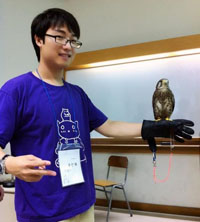 For 3 years, RYU Sung-ryong (25), who is studying veterinary medicine at Seoul National University, has conducted an animal-assisted therapy class for children suffering from cancer. During the class, about 20 children with cancer get to interact with dogs and cats, which help improve their emotional and social abilities. The sessions take place on SNU campus twice a week throughout the summer break.
For 3 years, RYU Sung-ryong (25), who is studying veterinary medicine at Seoul National University, has conducted an animal-assisted therapy class for children suffering from cancer. During the class, about 20 children with cancer get to interact with dogs and cats, which help improve their emotional and social abilities. The sessions take place on SNU campus twice a week throughout the summer break.
It was Ryu’s volunteer work at Korea Pediatric Cancer Foundation that gave him the idea of using animal-assisted therapy for children with cancer. While helping the kids study at the center, he realized that animal-assisted therapy can have many emotional benefits for cancer-stricken children as well, though the therapy is usually used for children with disabilities or autism.
“Oftentimes, kids with cancer are not very sociable, because they’ve had little experience in going to school and making friends. Those who are cured and go back to school tend to find it very difficult to interact with friends, and in some cases the child even gets bullied and suffers from depression,” said Ryu.
In 2010, when Ryu along with some of his friends invited 20 child cancer patients over to school for the first time, there were only a few puppies to show the children. However, over the last three years, the small gathering has become an official club named “Hu-Ani-One” with more than 20 students from the College of Veterinary Medicine regularly participating. Meanwhile, Ryu has obtained an animal-assisted therapist’s certificate. Along with the change, the class was also able to invite a professional animal-assisted therapist, and had an eagle-owl, a national monument, meet the children.
In Ryu’s class, children, who are caught up in their own world battling against cancer every minute of their lives, become different. Kids learn what it is like to care about “others,” by playing with animals, and making food for them. A simple activity such as throwing a ball to a dog can open up a whole new world for the children.
“Once the kids start to like the animals, they try to figure out what they can do to make the animals like them back. It is amazing to witness how these children, who were not even willing to make eye contact at first, begin to feel connectedness and become more thoughtful. In the meantime, gradually, wounds in their heart get healed,” said Ryu.
 When asked about the most memorable moment during his work, Ryu recalled one time when a mother, with teary eyes, came up to him and told him about how her child finally after three years of vain efforts overcame depression thanks to the class. “In fact, there are many kids who declare that they will ‘get healthy and go back to school,’ start eating well and become cheerful,” said Ryu with a proud smile on his face.
When asked about the most memorable moment during his work, Ryu recalled one time when a mother, with teary eyes, came up to him and told him about how her child finally after three years of vain efforts overcame depression thanks to the class. “In fact, there are many kids who declare that they will ‘get healthy and go back to school,’ start eating well and become cheerful,” said Ryu with a proud smile on his face.
Recently, Seoul National University presented the Gwanak Volunteer Work Service Award to Ryu for his dedication. Ryu expressed that he would like to continue his work with the animal class and study more so that he may be able to contribute to society by helping realize “happy encounters between humans and animals.”
Pointing out how having a pet can induce a wholesome, warm family atmosphere, Ryu explained his belief that “our society can be a happier place if more people get to experience growing up with a pet.” At the moment, his future plan is to study veterinary medicine and family psychology, and then become a veterinarian who focuses on bringing animals into people’s lives.
Written by LEE Sukyoung, SNU English Editor, sukyoung123n@gmail.com Reviewed by Eli Park Sorensen, SNU Professor of Liberal Studies, eps7257@snu.ac.kr Proofread by Brett Johnson, SNU English Editor, morningcalm2@gmail.com

